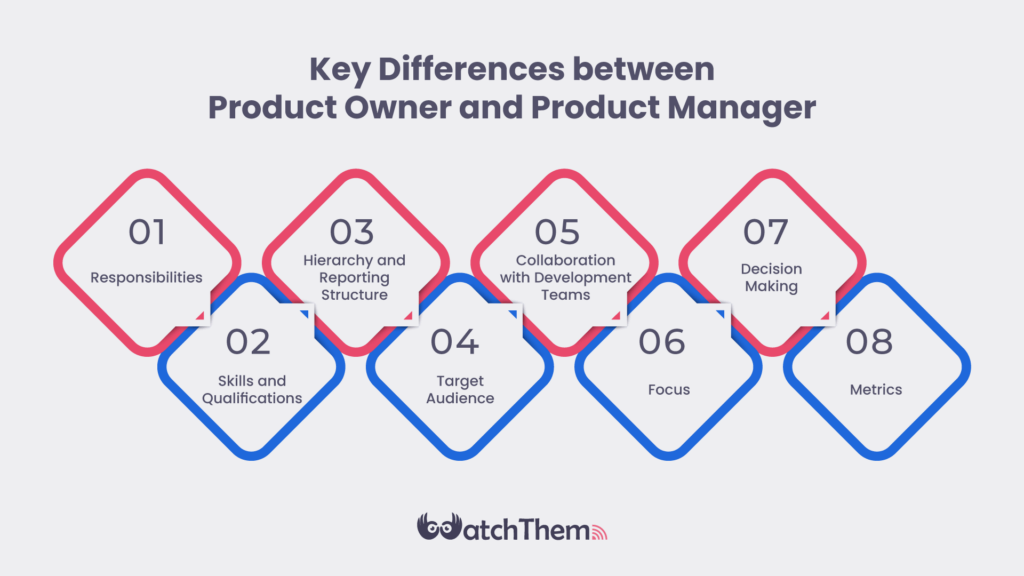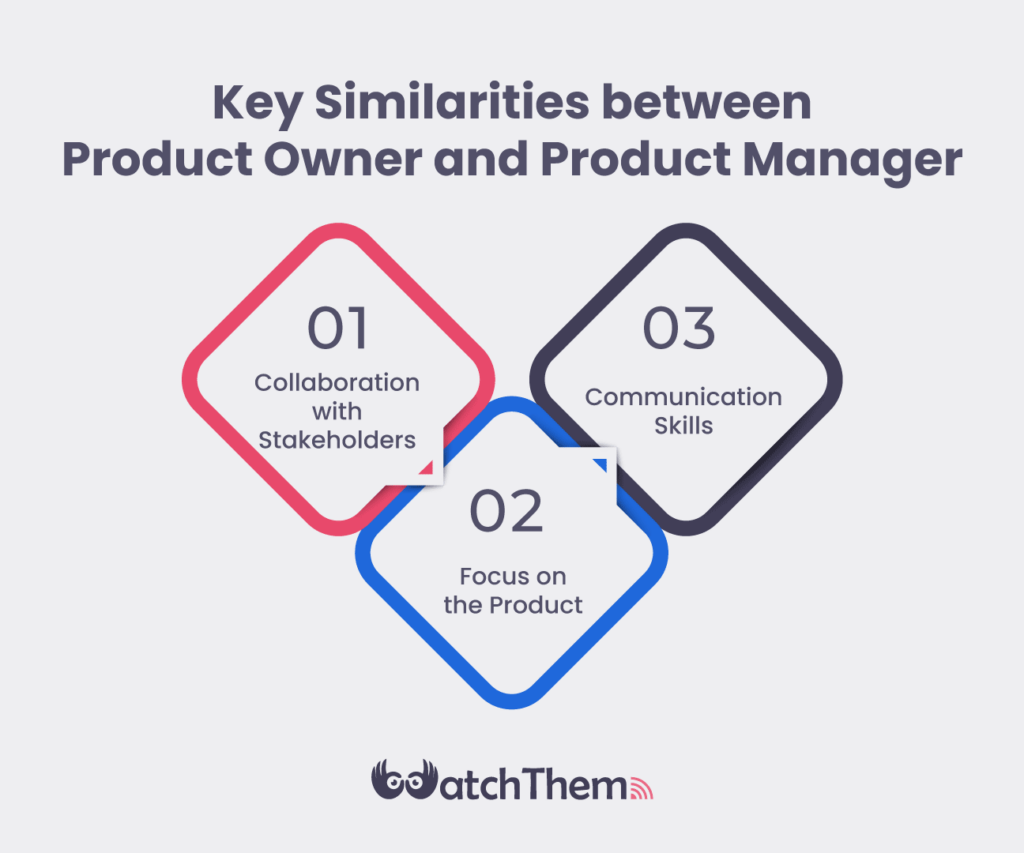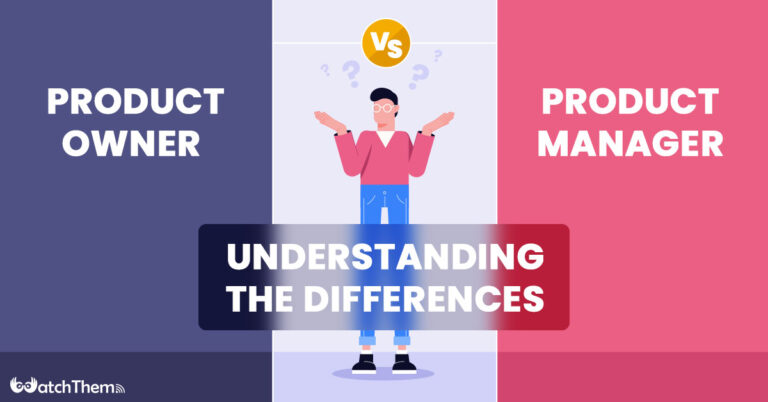Page Contents
Product development is a complex and collaborative process that requires different roles and skill sets. Two of the key roles in product development are the product owner and product manager. While these roles share some similarities, they have distinct responsibilities that are essential for creating successful products.
Product owners and managers use different tools to help them effectively manage and prioritize their product development process. CRO tools are increasingly becoming an essential component of product development.
One such tool is WatchThemLive, which provides organizations with valuable insights into user behavior.
In this article, we will explore the differences between product owner and product manager roles and how they work together in product development. We will also discuss how CRO tools like WatchThemLive can be used to optimize the product development process.
Who Is a Product Owner
A product owner is a member of an agile development team who is responsible for defining and prioritizing the product backlog. The product backlog is a list of features and user stories that the development team will work on during a given sprint.
The product owner is responsible for ensuring that the backlog is complete and up-to-date.
In addition to managing the backlog, the product owner is also responsible for communicating the product vision to the development team and stakeholders. This includes defining the product’s goals, objectives, and target market, and ensuring that everyone understands what the product is supposed to do and why it’s valuable.
They also provide feedback on features as they are developed and make sure that the team is building the right thing at the right time.
Product owners use UX analytic tools to gain insight into users’ behavior and feedback, and make informed decisions about which features to prioritize.
Who Is a Product Manager
According to a 2020 survey of product professionals, 57% of respondents identified as product managers, while 28% identified as product owners.
A product manager is responsible for the overall success of the product. They are responsible for the product’s strategy, roadmap, and go-to-market plan.
The product manager is the voice of the customer and the market, and they work closely with cross-functional teams.
They are responsible for defining the product’s positioning, messaging, and target market. They conduct market research to identify customer needs and trends and work with the development team to ensure that the product is meeting those needs.
In addition to defining the product’s strategy and roadmap, the product manager is also responsible for the product’s go-to-market plan. This includes pricing, promotion, and distribution strategies, as well as working with sales and marketing teams to ensure that the product is successfully launched and adopted by customers.
Key Differences between Product Owner and Product Manager
Now that we’ve defined each role, let’s explore the key differences between a product owner and a product manager.


Responsibilities
The main difference between a product owner and a product manager is their responsibilities. A product owner’s responsibility is primarily focused on the development team and ensuring that the product backlog is up-to-date and reflects the needs of the business and the end-users.
A product manager’s responsibility, on the other hand, is focused on the overall success of the product. They are responsible for the product’s strategy, roadmap, and go-to-market plan, and work closely with cross-functional teams to ensure that the product meets the needs of both the customer and the business.
Skills and Qualifications
Because of their different responsibilities, product owners and product managers require different skill sets and qualifications.
A product owner should have strong communication and collaboration skills, as they work closely with the development team to ensure that the product backlog is up-to-date and reflects the needs of the business and the end-users.
They should also have a deep understanding of the product and the end-users using behavioral analytic tools, and be able to prioritize the backlog based on business value and customer needs.
A product manager, on the other hand, should have strong strategic and analytical skills as they are responsible for defining the product’s strategy, roadmap, and go-to-market plan.
They should be able to conduct and evaluate the market research process to identify customer needs and trends, and be able to translate that information into a product strategy. They should also have strong leadership and cross-functional collaboration skills, as they work closely with teams across the organization to ensure the success of the product.
In terms of qualifications, both roles typically require a bachelor’s degree, although the field of study can vary. Product owners often come from a technical background, such as software development, while product managers often come from a business or marketing background.
Both roles also benefit from certifications such as Certified Scrum Product Owner (CSPO) or Certified Product Manager (CPM).
Hierarchy and Reporting Structure
Another difference between product owners and product managers is their position within the organization and their reporting structure.
Product owners are typically members of an agile development team, and report to the Scrum Master. The Scrum Master is responsible for facilitating the agile development process and ensuring that the team is following agile principles and practices.
The product owner works closely with the Scrum Master to ensure that the product backlog is up-to-date and reflects the needs of the business and the end-users.
Target Audience
The product owner is the voice of the customer and works to ensure that the product meets the needs of the target audience. They prioritize the product backlog based on the customer’s needs and work closely with stakeholders, including customers, to gain insights into user behavior and feedback.
The product manager also works closely with the target audience, but their focus is on identifying market opportunities and ensuring that the product meets business goals. They work closely with the sales and marketing teams to understand market trends and identify potential areas for growth.
Collaboration with Development Teams
Both the product owner and product manager work closely with the development team to ensure that the product is delivered on time and within budget. However, their level of involvement differs.
The product owner works closely with the development team to ensure that the product backlog is prioritized correctly and that the development team has a clear understanding of the product vision and requirements.
The product manager also works closely with the development team but focuses more on ensuring that the product is delivered on time and within budget. They work with the development team to identify potential roadblocks and ensure that the product is delivered according to the product roadmap.
Product managers are often part of the product management team or a larger product organization. They may report to a Director of Product or a Vice President of Product, and work closely with cross-functional teams across the organization.
Focus
Product owners focus on the day-to-day tasks of product development, such as creating and maintaining the product backlog, working with the development team to refine user stories, and providing feedback on the product’s features and functionality.
Product managers, on the other hand, focus on the big picture, such as developing the product strategy, identifying market trends, and defining the product roadmap.
Decision Making
Product owners make decisions about the day-to-day tasks, such as which user stories to prioritize and how to refine them. Product managers make decisions about the overall product strategy, such as which features to prioritize based on the product’s goals and objectives.
Metrics
Product owners are responsible for defining and tracking product metrics that measure the success of the product, such as user adoption and engagement.
Product managers are responsible for defining and tracking metrics that measure the success of the product strategy, such as market share and revenue growth.
Key Similarities between Product Owner and Product Manager
Although there are some significant differences between the product owner and product manager roles, they share some similarities.


Collaboration with Stakeholders
Both the product owner and product manager work closely with stakeholders to ensure that the product meets business objectives and user needs.
They work with stakeholders to gain insights into user behavior and feedback and use this information to prioritize the product backlog and make product decisions.
Focus on the Product
Both the product owner and product manager have a laser focus on the product. They work to ensure that the product meets business goals, user needs, and aligns with the product vision.
Communication Skills
Both the product owner and project manager need to have excellent communication skills. They need to communicate the product vision, progress, and requirements to stakeholders, including customers, the development team, and the sales and marketing teams.
Why Understanding the Differences is Important
Understanding the differences between product owners and product managers is essential for optimizing the product development process and improving the customer experience.
When the roles are clearly defined, product owners and product managers can work together effectively to ensure that the product meets the needs of the market and the business.
When the roles are not clearly defined, it can lead to confusion and inefficiencies in the product development process. For example, if the product owner is making decisions about the product strategy, it can lead to a misalignment between the product backlog and the product strategy.
Similarly, if the product manager is making decisions about the day-to-day tasks of product development, it can lead to a misalignment between the product strategy and the actual product development.
Strategies for Effective Collaboration Between Product Owners and Product Managers
In order for a product to be successful, it’s important for the product owner and product manager to collaborate effectively. While the two roles may have different responsibilities, they share a common goal of creating a successful product that meets the needs of the customer and aligns with the business objectives.
Here are some strategies for effective collaboration between product owners and product managers that lead to optimized conversion rate:
Clearly define roles and responsibilities: To avoid confusion and conflicts, it’s important to clearly define the roles and responsibilities of each team member. This can help ensure that everyone understands their own responsibilities and how they fit into the larger picture.
Establish open lines of communication: Good communication is essential for effective collaboration. Product owners and managers should hold regular meetings to discuss project progress, prioritize tasks, and resolve any issues that may arise.
Foster a culture of collaboration: Encourage collaboration between team members by creating a positive work environment that values open communication, teamwork, and mutual respect. This can help create a sense of shared ownership and accountability for the success of the product.
Build trust: Trust is essential for effective collaboration. Product owners and managers should work to build trust between each other by being transparent, honest, and reliable in their communication and actions.
Use tools and technologies to facilitate collaboration: There are a variety of tools and technologies such as CRO tools available that can help facilitate collaboration between product owners and managers.
CRO tools are becoming increasingly popular in product development due to their ability to provide valuable insights into user behavior and optimize products for better user experiences. One such tool is WatchThemLive, which offers organizations a unique opportunity to observe real-time user behavior on their website or app.
WatchThemLive provides a wealth of information about how users interact with a product, including where they click, how they navigate, and where they encounter problems.
This information can be used to identify pain points and opportunities for improvement, as well as test and validate hypotheses about user behavior. By optimizing products for better conversion rates and user experiences, WatchThemLive can help organizations increase customer satisfaction and loyalty, ultimately driving business success.
With WatchThemLive, product owners and managers can gain insights that are essential for creating successful products that meet the needs of their users.
By following these strategies, product owners and managers can work together more effectively to create successful products that meet the needs of the customer and align with the business objectives.
Effective collaboration can also help create a more positive work environment and improve team morale, ultimately leading to greater success and productivity.
Tips for Hiring the Right Person for the Job
Now that we’ve explored the differences between product owners and product managers, let’s discuss some tips for hiring the right person for the job.
- First, it’s important to clearly define the responsibilities of the role and the skills and qualifications required. This will help you attract the right candidates and ensure that you are hiring someone who can effectively perform the role.
- Second, consider the size and stage of your organization. If you are a small startup, you may only need a product owner who can work closely with the development team and ensure that the product backlog is up-to-date.
If you are a larger organization with multiple products and a more complex market, you may need a product manager who can define the product’s marketing strategy and go-to-market plan.
- Third, look for candidates who have experience in your industry or market. They will have a better understanding of customer needs and trends and will be able to translate that information into a product strategy.
- Fourth, assess the candidate’s communication and collaboration skills. Both product owners and product managers need to be able to work effectively with cross-functional teams, so it’s important to find someone who can communicate clearly and collaborate effectively.
- Finally, consider the candidate’s leadership skills. Product managers need to be able to lead cross-functional teams and drive the success of the product, so it’s important to find someone who can inspire and motivate others.
People Also Asked about Product Owner vs. Product Manager
In this article, you learned all you needed to know about product owner vs project manager. Now it’s time to go over some frequently asked questions. So keep scrolling!
Q1. What Qualifications Are Needed to Become a Product Owner or Product Manager?
To become a product owner or product manager, a candidate typically needs a bachelor’s degree in a relevant field, such as business, computer science, or engineering. Some employers may also require a master’s degree. Additionally, candidates should have experience in product management or a related field, such as marketing or software development. Strong communication, analytical, and leadership skills are also essential.
Q2. Can One Person Perform Both the Product Owner and Product Manager Roles?
While it’s possible for one person to perform both the product owner and product manager roles, it’s not ideal. These roles require different skill sets and focus on different aspects of the product development process. Combining these roles can result in a lack of focus and may lead to confusion and inefficiencies.
Q3. Is It Necessary for Every Organization to Have Both a Product Owner and Product Manager?
It’s not necessary for every organization to have both a product owner and product manager, but it’s recommended. These roles have different responsibilities and focus on different aspects of product development, which can help ensure that the product meets the needs of the customer and business goals.
Conclusion
In conclusion, the product owner and product manager roles are both critical to product development. While they have different responsibilities, they work together to create successful products that meet the needs of the customer and business goals.
In addition to having a strong understanding of product development, having the right tools to support product development efforts is also essential. WatchThemLive is an excellent CRO tool that organizations can use to gain insights into user behavior and optimize their products for better user experiences.
With the right tools and collaboration between product owners and product managers, organizations can create products that are successful and meet the needs of their customers.

